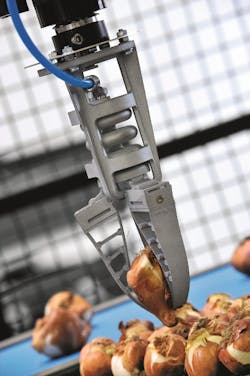Pick-and-place robots have become fairly ubiquitous over the past decade. They're nearly as commonplace in the aisles of technology trade fairs as end-cap displays are in grocery stores.
So it's interesting to see that the next steps in the evolution of pick-and-place robotics are beginning to roll out.One such introduction comes from Festo, which has released its adaptive gripper DHDG. The gripper consists of a pneumatic actuator in the form of a bellows and three gripper fingers arranged in what Festo calls the "fin ray pattern‚" a design based on the tail fin of a fish.
The basic structure of the gripper is comprised of two flexible bands that meet at one end to form a triangle. Intermediate stays are connected to the bands at regular intervals by articulated joints.
According to Festo, this flexible design enables the gripper fingers to adapt to the shape of a work piece when pressure is applied laterally, much like the human hand.
To execute the nimble, pressure-sensitive function of the human hand, the gripper employs the use of a proportional pneumatic valve to ensure that the correct amount of pressure is applied. The use of this valve allows individual acceleration and pressure ramps to be applied. The variable flow rates provided by the proportional valves allow the cylinder pressures to be adapted to a given production or sorting process.
All functions of the tripod robotic handling unit are controlled by the CMXR robotic controller.
The fin ray design pattern of the adaptive gripper is manufactured using selective laser sintering. In this process, successive layers of polyamide powder of a thickness of .00394 inches (0.1 mm) are applied and allowed to harden to form a solid component. This reduces the weight acting on the tool carrier by at least 90 percent compared with a conventional metal gripper. This extremely light-weight characteristic of the gripper means that it can grip and transport work pieces in an energy-efficient manner.
Festo
www.festo.com/us
Leaders relevant to this article:


